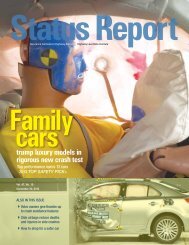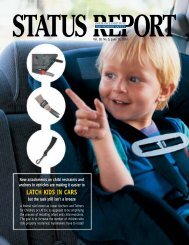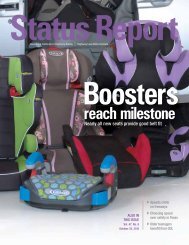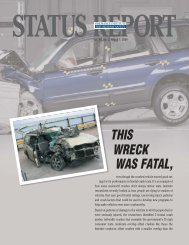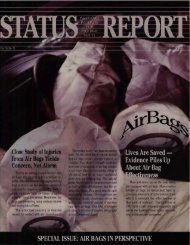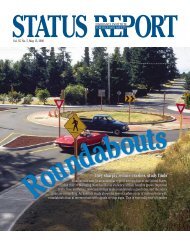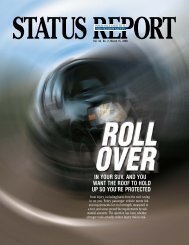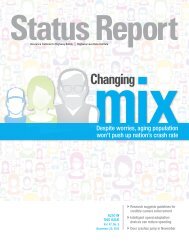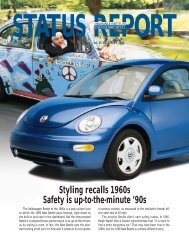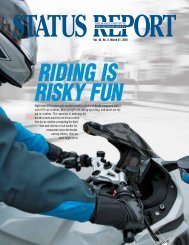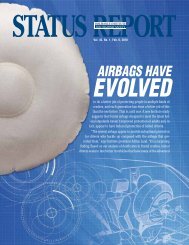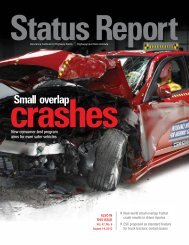IIHS Status Report, Vol. 43, No. 4, June 9, 2008 - Insurance Institute ...
IIHS Status Report, Vol. 43, No. 4, June 9, 2008 - Insurance Institute ...
IIHS Status Report, Vol. 43, No. 4, June 9, 2008 - Insurance Institute ...
- No tags were found...
You also want an ePaper? Increase the reach of your titles
YUMPU automatically turns print PDFs into web optimized ePapers that Google loves.
<strong>Vol</strong>. <strong>43</strong>, <strong>No</strong>. 4, <strong>June</strong> 9, <strong>2008</strong>TEENSTALKa lot, and they like theircellphones. Some ofthem especially liketo gab while driving,even whenthey aren’t supposedto bephoning ortexting.A new
2 <strong>Status</strong> <strong>Report</strong>, <strong>Vol</strong>. <strong>43</strong>, <strong>No</strong>. 4, <strong>June</strong> 9, <strong>2008</strong><strong>Institute</strong> study of cellphone use amongyoung drivers in <strong>No</strong>rth Carolina found thatteens often ignore cellphone bans. The studyis the first to examine what teenagers andtheir parents think of such restrictions.Most parents and teens said they supportthe state’s cellphone ban forteenage drivers but believe it isn’toften enforced. Researchers concludedthe ban hadn’t reduced teen drivercellphone use five monthsafter it took effect.Phone bans for youngdrivers are becoming commonplaceas concernsmount about the contributionof distractions toteens’ elevated crash risk.Young motorists are more likelythan older ones to talk on phoneswhile driving (see <strong>Status</strong> <strong>Report</strong>,Jan. 28, 2006; on the web atiihs.org). Seventeen states andthe District of Columbia restrictboth hand-held and hands-freephone use by young drivers.Six states and DC bar all driversfrom using hand-helds.<strong>No</strong>rth Carolina’s restrictionis part of its graduatedlicensing system for youngbeginning drivers. Thoseyounger than age 18 can’tuse hand-held or hands-freephones or text messaging systems.Penalties include a $25fine and a 6-month delay inadvancing to the next licensinglevel. Calls to parents,guardians, spouses, medicalproviders, and emergencyservices are permitted.“Most young drivers complywith graduated licensingrestrictions such as limits onnighttime driving and passengers,even when enforcementis low,” says Anne McCartt,<strong>Institute</strong> senior vice presidentfor research and an author ofthe study. “The hope in <strong>No</strong>rthCarolina was that the sameMOST YOUNG DRIVERS COMPLY WITH RESTRICTIONS SUCH ASLIMITS ON NIGHTTIME DRIVING, EVEN WHEN ENFORCEMENT ISLOW. THE HOPE IN NORTH CAROLINA WAS THAT THIS WOULDHOLD TRUE FOR CELLPHONE USE, TOO, BUT IT HASN’T. TEENSAREN’T COMPLYING WITH THE BAN ON TALKING WHILE DRIVING.PARENTS PLAY A BIG ROLE IN ENSURING TEENS’ COMPLIANCEWITH GRADUATED LICENSING RULES, BUT PHONES PRESENT ACHALLENGE: PARENTS WHO WANT THEIR TEENS TO CARRY THEMMAY FIND IT TOUGH TO ENFORCE RULES ABOUT WHEN TO TALK.
<strong>Status</strong> <strong>Report</strong>, <strong>Vol</strong>. <strong>43</strong>, <strong>No</strong>. 4, <strong>June</strong> 9, <strong>2008</strong> 3105NC PARENTS’ AND TEENAGERS’ VIEWS ABOUTCELLPHONE LAW AND PARENTAL RESTRICTIONSAFTER LAWteenagers parentsknow about law 64% 39%approve of law 74% 95%believe law being 22% 13%enforced fairly often/a lotif teenager has cellphone, 66% 88%parent restricts teenager’sphone use while drivingOBSERVED PERCENTAGES OF CELLPHONEUSE AMONG TEENAGE DRIVERSprelaw postlawNORTH CAROLINAprelaw postlawSOUTH CAROLINAwould hold true for cellphone use, butthis wasn’t the case. Parents play a bigrole in compliance with graduated licensingrules. Limiting phone use may betougher for them since many want theirteens to carry phones.”More than 255 million people in theUnited States have wireless phone subscriptions,according to the Cellular Telecommunicationsand Internet Association.It’s hard to gauge accurately how manydrivers use phones, but federal observationaldata indicate that 745,000 passengervehicles at any moment during theday are being driven by people usinghand-held phones.Data tying hand-held or hands-freephone use to crashes are scarce, but evidenceis accumulating that the practiceincreases crash risk. A 2005 <strong>Institute</strong>study of drivers in Western Australiafound cellphone users four times as likelyto get into crashes serious enough toinjure themselves. The risk was the samefor hand-held and hands-free phone users(see <strong>Status</strong> <strong>Report</strong>, July 16, 2005; on theweb at iihs.org). These findings are consistentwith 1997 Canadian research linkingdriver phone use to a fourfold increasein the risk of a property damagecrash (see <strong>Status</strong> <strong>Report</strong>, March 22, 1997;on the web at iihs.org).In <strong>No</strong>rth Carolina, observed cellphoneuse by teen drivers leaving school in theafternoon rose slightly, from 11 percent 1to 2 months before the law to 12 percent 5months after it took effect on Dec. 1, 2006.Most drivers were using hand-helds. Ninepercent held phones to their ears, whilefewer than 1 percent were using handsfreedevices. About 2 percent were observeddialing or texting. Cellphone useremained steady at about 13 percent atcomparison sites in South Carolina, whichdoesn’t restrict teen drivers’ phone use.In both states, use of cellphones washigher among girls than among boys andhigher when teens drove alone in vehiclesrather than with friends. For example, 13percent of female drivers and 9 percent ofmales were observed using cellphones in<strong>No</strong>rth Carolina before the law. Cellphoneuse was 14 percent among solo driversand 8 percent among teens with 1 passenger.More SUV drivers than car driverswere viewed using phones.The study coupled driver observationswith telephone surveys of <strong>No</strong>rthCarolina parents and their teenage children.After the law took effect, about twothirdsof teens and 39 percent of parentssaid they know about the cellphone ban.Eighty-eight percent of parents said theyrestrict their teen drivers’ cellphone use,though only 66 percent of teens reportedsuch parental limits. Three-quarters ofteens and 95 percent of parents said theyapprove of the law.Teenagers surveyed after the law tookeffect didn’t use their phones as much asthose surveyed before the law. Fifty-onepercent of teen drivers before and 31 percentafter said they’d often or sometimestalked on their phones. Most parents andteen drivers agreed that police officersweren’t looking for cellphone violators.Only 22 percent of teens and 13 percent ofparents believed the ban was enforcedfairly often or a lot.“Cellphone bans for teen drivers aredifficult to enforce,” McCartt notes. “Driverswith phones to their ears aren’t hardto spot, but it’s nearly impossible forpolice officers to see hands-free devicesor correctly guess how old drivers are.”Absent some better way to enforcethem, “cellphone bans for teenage driversaren’t effective, based on what we saw in<strong>No</strong>rth Carolina,” McCartt adds. “Passageof a law is just a first step. The restrictionsneed to be well-publicized and enforcementshould be highly visible.”Studies of hand-held cellphone banscovering all drivers in New York and theDistrict of Columbia found greater complianceover the longer run in DC, likelybecause of tougher enforcement (see <strong>Status</strong><strong>Report</strong>, July 16, 2005; on the web at iihs.org).For a copy of “Short-term effects of ateenage driver cellphone restriction” byR.D. Foss et. al, write publications, <strong>Insurance</strong><strong>Institute</strong> for Highway Safety, 1005 N.Glebe Rd., Arlington, Va. 22201; or emailpublications@iihs.org.
4 <strong>Status</strong> <strong>Report</strong>, <strong>Vol</strong>. <strong>43</strong>, <strong>No</strong>. 4, <strong>June</strong> 9, <strong>2008</strong>ROUNDABOUTSCAN BE EVEN SAFERWITH EASY CHANGESRoundabouts are vastly safer than traditionalintersections, and most drivers like thecircular intersections once they get used tothem. Still, some mostly minor collisions dooccur at roundabouts, and some motoristsfind them confusing or worry they’re unsafe.One common type of crash happens whena vehicle runs off the road, likely because thedriver didn’t see the roundabout in time orslow down soon enough. Relatively simplechanges like better lighting, pavement markings,and landscaping could reduce crashesby helping motorists navigate roundaboutsmore safely.In the first formal analysis of crashes atUS roundabouts, <strong>Institute</strong> researchers examinedpolice reports for crashes that occurredat 38 locations in Maryland. The state was anearly adopter of the modern roundabout,introducing the first one in 1993 and buildinga total of about 46 by August 2005. Thereview includes 149 crashes at 29 single-laneroundabouts and 134 crashes at 9 doublelaneroundabouts.“Modern roundabouts virtually eliminatethe most serious kinds of crashes that occurat traditional intersections controlled bytraffic signals or signs. Because they keeptraffic moving, they handle more vehicles atonce than traditional intersections can, savingfuel and time,” says Anne McCartt,<strong>Institute</strong> senior vice president for researchand an author of the study. “When crashesoccur at roundabouts, they tend to be minor,mostly involving just property damage.Relatively simple enhancements can makeexisting roundabouts even safer.”Where roundabouts have been installed,crashes have declined about 40 percent, andthose involving injuries have been reducedabout 80 percent (see <strong>Status</strong> <strong>Report</strong>, May 13,2000; on the web at iihs.org). More than1,000 roundabouts have been built in theUnited States, and many more are planned orunder construction. Support for roundaboutshas increased over time in communi-ties where they’ve been installed, as peopleget used to the new traffic patterns. Motoristswho disapprove of roundabouts mostfrequently cite safety concerns and confusionabout how to navigate them (see <strong>Status</strong><strong>Report</strong>, July 28, 2001, and <strong>No</strong>v. 19, 2005; onthe web at iihs.org).US roundabouts feature a raised centerisland that vehicles travel around in a counterclockwisepattern. Entering traffic yieldsthe right of way to circulating vehicles. Thecenter island and the tight radius ofentrances and exits help to keep travelspeeds down to about 15-20 mph in urbanareas and about 30-35 mph on rural roads.Slower speeds help vehicles merge moreeasily and reduce the severity of the crashesthat do occur.Three main typesof crashes account for amajority of those that occurat roundabouts, accordingto European and Australian studies:collisions between entering andcirculating vehicles, run-off-the-road crashes,and rear-enders. In Maryland, <strong>Institute</strong>researchers identified sideswipes as a fourthtype prevalent at double-lane roundabouts.About three-quarters of the crashes in thestudy involved only property damage, andno crashes were deadly.Crashes happened disproportionately atentrances to roundabouts. About 80 percentof collisions at single-lane roundabouts andabout 60 percent of those at double-laneroundabouts occurred at entrances. FifteenDREFLEAND ENHAISLANR
<strong>Status</strong> <strong>Report</strong>, <strong>Vol</strong>. <strong>43</strong>, <strong>No</strong>. 4, <strong>June</strong> 9, <strong>2008</strong> 5BIGGERSIGNS ALERTINGRIVERS TO ROUNDABOUTS,CTIVE PAVEMENT MARKERS,NCED LANDSCAPING OF CENTERDS CAN HELP DRIVERS RECOGNIZEOUNDABOUTS, SLOW DOWN,AND PREPARE TOYIELD.percentof the crashesat single-laneroundabouts and28 percent at doublelaneroundabouts involvedvehicles traveling incirculating lanes. The rest of thecrashes (about 4 percent at singlelaneroundabouts and 12 percent atdouble-lane roundabouts) occurred at exits.Running off the road accounted for half ofthe crashes that occurred at single-lane roundaboutsand 28 percent at double-lane ones. Acommon crash pattern in- (continues on p. 7)REDESIGNED AIRBAGS SAFEGUARDBOTH CHILDREN AND GROWN-UPSFrontal airbags that have been redesigned do a better job than older airbagsof protecting the youngest vehicle occupants without increasing injury ordeath risk for adults. This is the main conclusion of a blue ribbon panel’s sixyearevaluation of the real-world performance of advanced airbags.In the mid 1990s inflating airbags were linked to some deaths and seriousinjuries that occurred in low-speed crashes. These particularly involved unrestrainedinfants and young children, infants in rear-facing restraints, andsmall adults sitting near the steering wheel. The National Highway TrafficSafety Administration (NHTSA) changed the test rules in 1997 so automakerscould depower frontal airbags starting with 1998 models and in 2001 issuedan advanced airbag rule. A federal appeals court upheld this decision (see<strong>Status</strong> <strong>Report</strong>, Aug. 1, 2004,and Aug. 6, 2005; on the webat iihs.org).Critics had argued thatreducing airbag power wouldcompromise occupant protection,especially for largerpeople, in crashes that occurat higher speeds, but studiesby <strong>Institute</strong> researchersandothers showedthis wasn’t thecase (see <strong>Status</strong><strong>Report</strong>, March6, 2004; on theweb at iihs.org). Occupantdeaths from inflatingairbags in low-speed crashes plunged as a result of depowering plus acampaign to educat e people about the importance of restraining infants andchildren in the back seats of vehicles.After gathering more information on the crash performance of newer airbagdesigns, the blue ribbon panel of researchers and others confirmed thatthe redesigns are working as intended. Panel chairman Susan Ferguson toldNHTSA there’s “an abundance of evidence that infant and child deaths fromdeploying airbags in low-speed crashes are greatly diminished.” She said that,“contrary to predictions, overall fatality risks in frontal crashes have not risenamong adult drivers and passengers in vehicles with redesigned airbags.”The panel noted some data suggesting a “somewhat elevated fatality riskamong a subset of unbelted drivers” in 1998-99 vehicles with redesigned airbagsand “some evidence that the risks of serious chest injury may be higher amongunbelted drivers in frontal crashes” in vehicles with redesigned airbags. Thepanel called for more examination of advanced airbags in newer vehicles.For a copy of “An overview of frontal airbag performance with changes infrontal crash-test requirements: findings of the Blue Ribbon Panel for theEvaluation of Advanced Technology Airbags,” go to www.regulations.gov.
SMART CAREARNS TOP RATINGSTHE <strong>2008</strong> SMART FORTWO, THE SMALLESTCAR FOR SALE IN THE UNITED STATES, EARNS THEINSTITUTE’S TOP RATING OF GOOD FOR OCCUPANT PROTECTION INFRONT AND SIDE CRASHES (ON THE WEB AT <strong>IIHS</strong>.ORG). ITS SEAT/HEAD RESTRAINTS EARNTHE SECOND HIGHEST RATING OF ACCEPTABLE FOR PROTECTION AGAINST WHIPLASH INREAR IMPACTS. THE SMART HAS THE LATEST SAFETY GEAR, INCLUDING ELECTRONICSTABILITY CONTROL AND SIDE AIRBAGS, BUT SIZE STILL MATTERS. THE SMART CAN’TPROTECT ITS OCCUPANTS AS WELL AS LARGER CARS WITH SIMILAR RATINGS.
<strong>Status</strong> <strong>Report</strong>, <strong>Vol</strong>. <strong>43</strong>, <strong>No</strong>. 4, <strong>June</strong> 9, <strong>2008</strong> 7(continued from p. 5) volved vehicles runninginto center islands. This is how almosthalf of the run-off-the-road crashes occurred.Other major crash types included rearendersand collisions involving an enteringand a circulating vehicle.Pedestrians or bicyclists accounted forjust 6 of 283 total crashes. All of these happenedat 2-lane roundabouts.Crash patterns varied by time of day.Run-off-road crashes accounted for morethan 60 percent of the evening/nighttimecrashes at both single- and double-laneroundabouts, compared with 35 percentof daytime crashes at single-laneroundabouts and 9 percent of daytimecrashes at double-lane ones.“Speeding was a big problem inmany of these crashes, and some ofthe drivers might not have seen theroundabouts in time, especially atnight,” McCartt points out. “The challengeis getting drivers to recognizeroundabouts and then slow down asthey approach and enter them. Designchanges like narrowing the entry lanes,adjusting the curvature of the approachroads, and lengthening the splitter islandsthat separate roundabouts’ approach andexit lanes can help.”Newer roundabouts tend to be betterdesigned than previous ones, taking into accountlessons learned from the earlier ones.But localities with older roundabouts don’thave to go back to the drawing board. The<strong>Institute</strong>’s study suggests that small changescan further enhance the already-substantialsafety of roundabouts.The most effective changes might beinexpensive ones. Reflective pavement markersand large “roundabout ahead” and“yield” signs could help alert drivers toroundabouts and the need to slow down andyield to circulating traffic. More shrubs andbrighter lighting could help drivers betterspot center islands.For a copy of “Crash patterns and potentialengineering countermeasures at Marylandroundabouts” by S. Mandavilli et al., write:Publications, <strong>Insurance</strong> <strong>Institute</strong> for HighwaySafety, 1005 N. Glebe Rd., Arlington, VA22201, or email publications@iihs.org.REMINDERS ARE EFFECTIVE IN CONVINCINGHOLDOUTS TO BUCKLE THEIR SAFETY BELTSEnhanced safety belt reminders increased front-seat occupant belt use by 3-4 percent comparedwith vehicles without them, indicates a new federal study examining systems in a widerange of vehicles. Certain types of reminders were more effective than others. The NationalHighway Traffic Safety Administration (NHTSA) study shows that reminders reach peoplewho don’t typically buckle up and is in line with previous <strong>Institute</strong> studies of systems in Fordand Honda vehicles (see <strong>Status</strong> <strong>Report</strong>, <strong>June</strong> 13, 2006; on the web at iihs.org).Boosting belt use by only a few percentage points may seem like a small feat, but theremaining nonusers and part-time belt users are the hardest to reach. Among them are driversages 16-24, men, people in pickuptrucks, and motorists who livein states with laws that don’t allowpolice to ticket solely for nonuse ofbelts. Convincing these people tobuckle up will save lives becausethe number of unrestrained fatallyinjured vehicle occupants is disproportionatelyhigh. Of the 24,656front-seat passenger vehicle occupantsages 16 and older who werekilled in crashes in 2006 and forwhom belt use was known, 54 percentweren’t buckled up.Belt reminders that persistbeyond the 4-to-8-second warningthat’s required by federal standardsbegan to prove effectivewhen Ford and other automakersvoluntarily adopted them (see<strong>Status</strong> <strong>Report</strong>, March 27, 2004; onthe web at iihs.org). The enhancedreminders in most passenger vehiclesconsist of intermittent lights plus chimes or buzzers. Virtually all <strong>2008</strong> model passengervehicles have some type of enhanced reminder for drivers. Eighty-seven percent have visualand audible reminders for drivers, and 75 percent have them for passengers in the front seat.“Nearly 20 percent of front-seat occupants don’t use safety belts, so we have room toimprove,” says Anne McCartt, <strong>Institute</strong> senior vice president for research. “NHTSA’s studyadds to our earlier evidence that reminders can get hard-to-convince motorists to buckle upmore often. We also know that drivers overwhelmingly like reminders.”NHTSA observed safety belt use among drivers and front-seat passengers in nearly 40,000vehicles in 8 states with and without laws that allow police to issue tickets solely for not bucklingup. Researchers matched tag numbers to registration records to determine vehicle identificationnumbers, then fed this information into a NHTSA database to determine beltreminder features like sound, icon, duration, and cycle. In addition to finding higher belt usein vehicles with enhanced reminders, the agency concluded that systems combining a recurringsound plus an icon had the most effect on driver belt use.For a copy of “The effectiveness of enhanced seat belt reminder systems: observationalfield data collection methodology and findings,” go to www.nhtsa.dot.gov.
NON-PROFIT ORG.U.S. POSTAGEPAIDPERMIT NO. 252ARLINGTON, VA1005 N. Glebe Rd., Arlington, VA 22201Phone 703/247-1500 Fax 247-1588Internet: www.iihs.org<strong>Vol</strong>. <strong>43</strong>, <strong>No</strong>. 4, <strong>June</strong> 9, <strong>2008</strong>Teenage drivers continue to use cellphonesdespite a <strong>No</strong>rth Carolina ban ..........................1Roundabouts can be even safer with somesimple changes like better signs, lights .........4Panel finds that redesigned airbags improveprotection for children and adults .................5SmartforTwo earns top ratings of good forprotection in front and side crashes ..............6Enhanced belt reminders are convincingdrivers and front-seat passengers to buckleup, NHTSA says ................................................7Contents may be republished with attribution.This publication is printed on recycled paper.The <strong>Insurance</strong> <strong>Institute</strong> for Highway Safety is anonprofit scientific and educational organizationdedicated to reducing deaths, injuries, and propertydamage from crashes on the nation’s highways.The <strong>Institute</strong> is wholly supported by auto insurers:21st Century <strong>Insurance</strong>AAA Mid-Atlantic <strong>Insurance</strong> GroupAffirmative <strong>Insurance</strong>AIG Agency AutoAIG DirectAlfa <strong>Insurance</strong>Alfa Alliance <strong>Insurance</strong> CorporationAllstate <strong>Insurance</strong> GroupAmerican Family Mutual <strong>Insurance</strong>American National Property and CasualtyAmeriprise Auto & HomeAmerisure <strong>Insurance</strong>Amica Mutual <strong>Insurance</strong> CompanyAuto Club GroupAuto Club South <strong>Insurance</strong> CompanyBituminous <strong>Insurance</strong> CompaniesBristol West <strong>Insurance</strong>Brotherhood MutualCalifornia State Automobile AssociationCapital <strong>Insurance</strong> GroupChubb Group of <strong>Insurance</strong> CompaniesConcord Group <strong>Insurance</strong> CompaniesCotton States <strong>Insurance</strong>COUNTRY <strong>Insurance</strong> & Financial ServicesCountrywide <strong>Insurance</strong> GroupErie <strong>Insurance</strong> GroupEsuranceFarm Bureau Financial ServicesFarm Bureau Mutual <strong>Insurance</strong> Company of IdahoFarmers <strong>Insurance</strong> Group of CompaniesFarmers Mutual of NebraskaFlorida Farm Bureau <strong>Insurance</strong> CompaniesFrankenmuth <strong>Insurance</strong>The GEICO GroupGainscoGeneral Casualty <strong>Insurance</strong> CompaniesGeorgia Farm Bureau <strong>Insurance</strong>GMAC <strong>Insurance</strong>Grange <strong>Insurance</strong>The HartfordHanover <strong>Insurance</strong> GroupHigh Point <strong>Insurance</strong> GroupHomeowners of AmericaICW GroupIndiana Farm Bureau <strong>Insurance</strong>Kemper, a Unitrin BusinessKentucky Farm Bureau <strong>Insurance</strong>Liberty MutualThe Main Street America GroupMarkel CorporationMercury <strong>Insurance</strong> GroupMetLife Auto & HomeMichigan <strong>Insurance</strong> CompanyMiddleOakMMG <strong>Insurance</strong>Mutual of Enumclaw <strong>Insurance</strong> CompanyNationwide <strong>Insurance</strong>N.C. Farm Bureau Mutual <strong>Insurance</strong> Company<strong>No</strong>dak Mutual <strong>Insurance</strong><strong>No</strong>rfolk & Dedham GroupOhio Casualty GroupOklahoma Farm Bureau Mutual <strong>Insurance</strong> CompanyOregon Mutual <strong>Insurance</strong>Palisades <strong>Insurance</strong>Pekin <strong>Insurance</strong>PEMCO <strong>Insurance</strong>The Progressive CorporationResponse <strong>Insurance</strong>Rockingham GroupSafeco <strong>Insurance</strong>Samsung Fire & Marine <strong>Insurance</strong> CompanyS.C. Farm Bureau Mutual <strong>Insurance</strong> CompanySECURA <strong>Insurance</strong>Shelter <strong>Insurance</strong>Sompo Japan <strong>Insurance</strong> Company of AmericaState Auto <strong>Insurance</strong> CompaniesState FarmTennessee Farmers Mutual <strong>Insurance</strong> CompanyTokio Marine NichidoThe Travelers CompaniesUnitrinUSAAVirginia Farm Bureau Mutual <strong>Insurance</strong>West Bend Mutual <strong>Insurance</strong> CompanyZurich <strong>No</strong>rth AmericaFUNDING ASSOCIATIONSAmerican <strong>Insurance</strong> AssociationNational Association of Mutual <strong>Insurance</strong> CompaniesProperty Casualty Insurers Association of America



